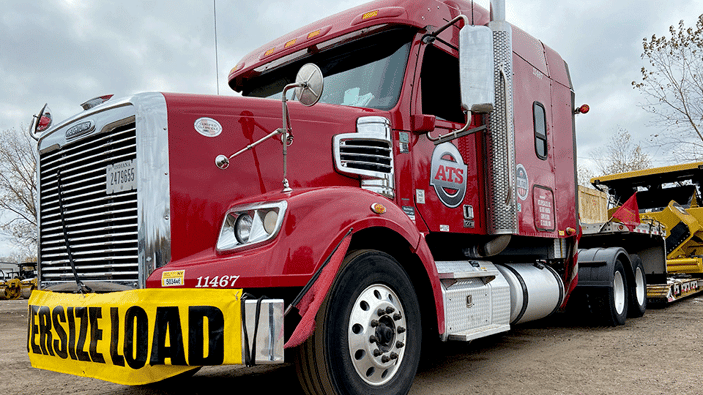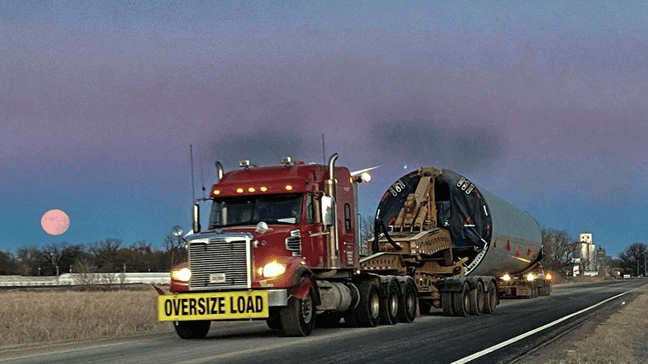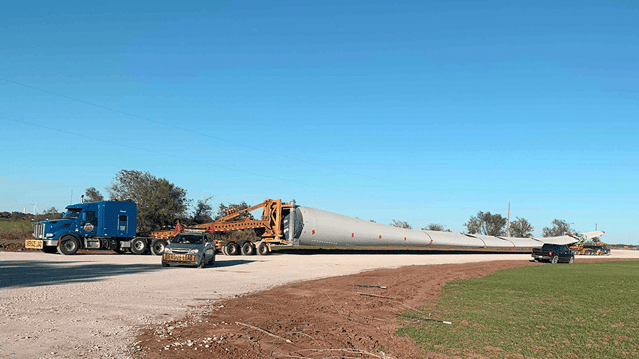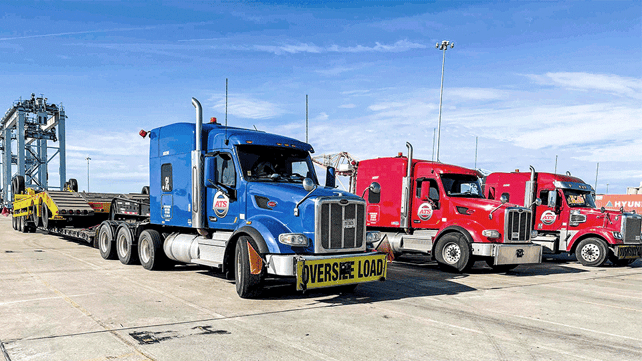
Transportation projects are many things: vital to the health of global supply chains; necessary for the continued improvement of our world; foundational to the success of many businesses.
But do you know what transportation projects aren’t? Simple to manage.
Whether it’s 15 truckloads of hospitality freight or multiple shipments of raw building materials, overseeing project shipments is complex at the best of times. This rings true even when the weather is clear, the route is clean and the freight in transit is legally proportioned.
So, when it comes to managing a project of oversized freight — no matter how large or small — being overwhelmed is understandable.
I mean, a single load of oversized freight, on its own, is difficult enough for shippers to navigate. Getting these shipments right requires a high level of oversight, expertise and planning from the party responsible for them.
For these loads, permits need to be acquired, a route needs to be planned and stakeholders at all levels (city, state and county) need to be notified.
These added intricacies make managing over-dimensional project shipments — like moving wind turbine components or batches of heavy machinery — really tough.
If you’ve ever navigated one of these projects in the past, it’s likely that you’ve experienced an unexpected delay or incident at some point. If so, you also know how damaging these mishaps can be to your bottom line, timelines and customer relationships.
Here at Anderson Trucking Service (ATS), we’ve been helping companies manage their over-dimensional transportation projects for decades now.
In this article, we’ll outline the top five problems shippers moving oversized goods run into on their projects and give you some tactics for avoiding them on your next one.
With the information provided below, you’ll be able to confidently execute your next transportation project and take solace in the fact that all the necessary pieces are in place for the fruitful facilitation of your supply chain.
The top five problems shippers run into on their oversized project shipments are:
- Making unplanned route changes
- Failing to plan for travel restrictions
- Permits expiring without proper planning
- Operating with a lack of area resources
- Missing permits on sequential project loads
Problem #1: Making Unplanned Route Changes
A route is everything to an over-dimensional shipment. Proper route planning can expedite timelines, help shippers avoid unnecessary fees and clear the way for a successful shipment.
When it comes to managing the movement of an OD project, the importance of solid route planning only multiplies. That said, some companies with project cargoes to move run into issues when they’re forced to deal with an unplanned change to their projected route.
Although this can happen due to a number of causes, some of the most common are:
- New road construction.
- Repairs to streets and highways.
- Curfews and time restrictions.
- Destination/sites changing locations/acceptable delivery dates.
- Prolonged permit turn times (because of short staffing or otherwise)
- Acts of God/natural disasters
- Low hanging trees, collapsed culverts, roadway obstructions.
- Riots.
As you may imagine, on a project where securing the correct permitting, notifying the right parties, utilizing route surveys and booking escorts, an unplanned route change can be catastrophic.
Once a shipment’s route changes, forcing companies to re-book permits and escorts, re-run route surveys and notify different individuals, you should expect delays to occur.
How to avoid this issue
This comes down to an oversight during the planning stage of a project.
Sure, it’s possible for something like bad weather, or another unforeseen problem to force a shipment to reroute. But this is far from the norm. Instead, the majority of re-routed shipments happen when due diligence is omitted in planning.
Nearly every construction and infrastructure project — two main causes of shipment re-routing — is planned for months in advance. Utilize this information by reaching out to area and local planning officials during the early stages of arranging your shipments. Make sure that shifting priorities (like roadway reconstruction) won’t impact your timelines.
With your trusted transportation provider(s) plan a route that fits the construction updates you’ve received and ensure that the route you utilize is viable from A to B.
Related Content: Project Freight Pickup and Delivery Planning Guide
Problem #2: Failing to Plan For Travel Restrictions

Moving over-dimensional freight is tricky — especially during certain times of the year. These oversized loads, more than anything else, must be transported with caution — in a way that protects the motoring public and truck drivers.
That said, as the calendar year wears on across the United States, there are various restrictions that come and go, from one area to another, complicating this further.
In the promotion of safety and to keep the roadways clear of hazards, most city, county and state governments have a running list of OD restrictions. Some shippers, fail to plan for the impact of these intricacies on their projects.
A few of the most common examples of OD time and curfew restrictions are:
- Daylight only restrictions
Other places prevent trucking companies and their drivers from transporting over-dimensional loads in the dark. Instead, these companies are only allowed to move cargo during daylight hours (usually starting 1/2 hour after sunrise and ending 1/2 hour before sunset).
- High commuter hours
In highly populated areas, oversized loads are prevented from moving freight during hours where instances of commuting are high. Although timeframes may vary, typically these restrictions happen in the following chunks: 7-9 a.m.; 11 a.m.-1 p.m.; and 3-6 p.m.
- Nighttime only restrictions
It’s not uncommon for some areas to limit the movement of large freight to nighttime hours. This helps to ensure that roads are clear of traffic while oversized freight is transported. This is particularly common for loads large enough to spill into an additional lane.
- Holiday restrictions
Some locations prevent over-dimensional freight from moving over national holiday periods when roads are crowded with traffic.
Although this is by no means a comprehensive list, and restrictions/curfews are often exacted on an individual level — large college towns prevent OD freight from moving through their cities on Saturday football game days, for example — you can imagine the problems these curfews can cause when not planned for.
How to avoid this issue
To avoid suddenly having to pivot your plans and rework your timelines due to an unforeseen curfew, make sure to get all necessary approvals ahead of time.
Area governing bodies don’t establish these rules on a whim. In most cases, over-dimensional freight restrictions have been in place for years, if not longer.
Use this to your advantage. Communicate with the transportation departments in the areas your project will traverse. Ask them about any upcoming or active restrictions that may impact your timelines.
Although it’s impossible to ignore these regulations — without significantly re-routing your load — it’s not difficult to plan for them with input from the correct parties.
Problem #3: Permits Expiring Without Proper Planning
Although exact timing will fluctuate based on your route and location, over-dimensional (OD) permits don’t last forever. Some permits last a number of days, while others last for upwards of a week or more. And, since possessing the proper permits to move a load is crucial to doing so, holding valid permits is non-negotiable.
That said, with so many other things to worry about on a project, sometimes, shippers see their permits expire before they can utilize them.
In these instances, instead of smoothly executing their shipment with all of the necessary pieces in place, shippers see their deadlines shift while they attempt to get permits extended, renewed and reordered.
Renewing permits, however, can be a lengthy, difficult process.
Many governing entities — charged with overseeing over-dimensional freight movement in their area — require shippers to have a valid reason for extending a permit.
While bad weather and equipment breakdowns are examples of valid reasons for permit extension, simply sighting “bad planning” won’t cut it.
Without an acceptable reason for why they need permits renewed, it’s not uncommon for companies to experience prolonged delays on their projects. In the worse cases, these delays can set their supply chains off course and their budgets into the red.
It’s fair to say, you’ll want to avoid this where you can.
How to avoid this issue
Proper planning with assistance from a competent transportation provider will be your best friend when it comes to managing your OD permits. The best carriers are seasoned experts in permitting best practices. These companies understand how long each permit (from each state) will last and how long (on average) it takes to secure them.
With these understandings in your corner, planning for the on-time facilitation of your projects won’t be an issue.
Problem #4: Operating With a Lack of Area Resources
When it comes to managing a project of over-dimensional freight, the number and diversity of resources you have access to can make or break your timelines. This is especially true as shipments get more specialized.
 The largest, most complex loads require things like engineering and utility services, pilot cars, patrol escorts and first-run surveys — to name a few. That said, without giving their transportation providers enough lead time to get these pieces — and all necessary permits — in place, shippers have trouble keeping their OD projects on track.
The largest, most complex loads require things like engineering and utility services, pilot cars, patrol escorts and first-run surveys — to name a few. That said, without giving their transportation providers enough lead time to get these pieces — and all necessary permits — in place, shippers have trouble keeping their OD projects on track.
Every complexity and challenge associated with moving a single OD shipment is multiplied when moving a project of them. Without enough area resources — resources that often need to be booked well in advance — shippers see their deadlines falter and projects stall.
How to avoid this issue
Prioritize communication, transparency and lead time when working with your transportation provider(s). Even the best carriers, with the widest network of resources, need time to set your project up for success.
Make sure to give these companies enough notice in advance of your projected “go date.”
Problem #5: Missing Permits on Sequential Project Loads
Some over-dimensional projects, like wind-turbine moves, are sequentially delivered based on the order in which each component will be assembled on-site.
Although these projects — when well managed — help companies keep to their assembly/delivery schedules, without securing permitting in the correct order, things can fall off track.
Sometimes — especially with too many hands in the mix — companies run into issues with a missing permit, or two, on their sequential shipments.

Unfortunately, when it’s time for an unpermitted shipment to move, this can stall an entire project while the necessary permits are acquired.
Should this oversight occur on the first shipment in a series of sequential loads, major problems like replacing expired permits and re-booking escort services can occur on all subsequent shipments.
How to avoid this issue
As previously mentioned, instances of missing permits most often occur when wires get crossed in planning. Having too many lines of communication and relationships to manage on a project can be detrimental to its success. For this reason, shippers that utilize multiple transportation providers for their OD projects most commonly run into these issues.
To avoid this in your own supply chain, consider whittling down the number of companies you utilize. With multiple carriers charged with overseeing various pieces of your projects, issues are far more likely to occur.
As such, you may be better served by finding a carrier that has the resources to reliably execute the entirety of your project and steer clear of utilizing multiple providers.
Avoid These Issues By Understanding Permitting Processes
Now that you understand five of the most common issues companies — like yours — run into when managing the movement of their over-dimensional freight, and have a few tactics for overcoming them, let’s take this a step further.
The process of securing oversized permitting can be intimidating for many shippers.
Without understanding the core aspects of getting them, including how long they should expect it to take, shippers can feel lost in the permitting process. And, in turn, run into issues on their projects.
Here at ATS, we understand the predicament the transportation world has put you in. And, to this point, it’s been difficult for companies to get succinct answers to their oversized permitting questions.
To give you these insights, insights that will help you move your project shipments, check out our article How To Get Oversized Load Permits For Your Freight (3 Easy Steps).
If, after reading it, you have any questions, please don’t hesitate to reach out. We’re happy to help you get your oversized shipping right in any way you need.




